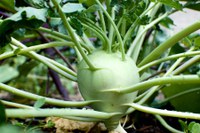Dakota Gardener: Spaceships in the Garden
(Click an image below to view a high-resolution image that can be downloaded)
By Tom Kalb, Horticulturist
NDSU Extension
Did you ever play basketball on your driveway?
I loved shooting hoops. I often pretended I was playing in a championship game. The imaginary crowd was cheering, and the final seconds were ticking off the clock. Five-four-three-two-one.
I would shoot the ball, hoping to make the winning basket.
Unfortunately, my basketball shots usually missed the basket and bounced into my neighbor’s garden.
Mr. Manion, my neighbor, was an avid gardener and a kind man. One day he asked me to come look at his garden.
I was a worried he noticed my latest basketball shot knocked over some of his bean plants. Instead, Mr. Manion wanted to show me a new vegetable he just harvested.
I had never seen that type of vegetable before. It looked weird.
It looked like a spaceship from Mars!
He sliced the UFO (unidentified food object) with his pocketknife and offered it to me.
The vegetable tasted like mild cabbage.
“Not bad,” I said.
I thanked him and ran away, hoping he would not see the damaged bean plants.
That introduction to kohlrabi was 50 years ago, and I will never forget it. Kohlrabi is so different. It looks crazy.
And it tastes so good. July is the best month to sow it.
The days are getting shorter, and fall is coming. We are coming upon a great time to sow many vegetables. Baby beets, kale and Swiss chard can be sown now.
Don’t forget about herbs. You can sow basil and cilantro now, dry them later, and enjoy them during winter.
In two to three weeks, we can be sowing spaceships (kohlrabi), spinach and turnips.
Many vegetables taste better when they ripen in the fall. The cool nights of autumn will increase the sweetness of the vegetables.
The best example of this is radishes. Many of us sow radishes in the spring. When we harvest them in early summer, they often taste bitter. That’s because the bulbs developed under warm temperatures.
If you sow your radishes in August, the bulbs will develop during the cool nights of September. The radishes will be crisp and mild. You will be amazed at the difference!
To plant a fall garden, begin by removing any debris from vegetables that have stopped producing. For me, it’s the old pea, lettuce and spinach plants.
Then replenish the soil with a light layer of compost or peat moss. A light application of fertilizer also will restore the soil’s fertility.
Sow your seeds when the soil is moist. Sow varieties that will ripen before our first hard frost, which is typically Sept. 25 to Oct. 5.
The soil is warm this time of year. You may wish to mulch the soil with some clean straw. Keep the soil a little moist until the seedlings get established.
North Dakota State University is testing several promising varieties of fall vegetables this year. We’ll send you a sample of seeds for free if you tell us how they perform in your garden.
Please contact me at tom.kalb@ndsu.edu. I will send you our 2021 fall catalog. All gardeners are welcome, and hundreds of families participate in these trials every year. Seed supplies are limited.
Children are especially encouraged to participate in these trials. They can grow their own spaceships in their garden.
For more information about gardening, contact your local NDSU Extension agent. Find the Extension office for your county at https://www.ag.ndsu.edu/extension/directory/counties.
NDSU Agriculture Communication - July 6, 2021
Source: Tom Kalb, 701-328-9722, tom.kalb@ndsu.edu
Editor: Ellen Crawford, 701-231-5391, ellen.crawford@ndsu.edu




